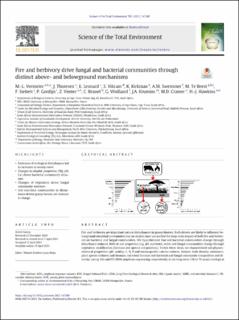Fire and herbivory drive fungal and bacterial communities through distinct above- and belowground mechanisms
Vermeire, Marie-Liesse; Thoresen, Joshua; Lennard, Katie; Vikram, Surendra; Kirkman, Kevin P.; Swemmer, Anthony M.; te Beest, Mariska; Siebert, Frances; Gordijn, Paul; Venter, Zander; Brunel, Caroline; Wolfaard, Graeme; Krumins, Jennifer Adams; Cramer, Michael Denis; Hawkins, Heidi-Jane
Peer reviewed, Journal article
Published version

Åpne
Permanent lenke
https://hdl.handle.net/11250/2987530Utgivelsesdato
2021Metadata
Vis full innførselSamlinger
- Publikasjoner fra CRIStin - NINA [2364]
- Scientific publications [1392]
Sammendrag
Fire and herbivory are important natural disturbances in grassy biomes. Both drivers are likely to influence be- lowground microbial communities but no studies have unravelled the long-term impact of both fire and herbiv- ory on bacterial and fungal communities. We hypothesized that soil bacterial communities change through disturbance-induced shifts in soil properties (e.g. pH, nutrients) while soil fungal communities change through vegetation modification (biomass and species composition). To test these ideas, we characterised soil physico- chemical properties (pH, acidity, C, N, P and exchangeable cations content, texture, bulk density, moisture), plant species richness and biomass, microbial biomass and bacterial and fungal community composition and di- versity (using 16S and ITS rRNA amplicon sequencing, respectively) in six long-term (18 to 70 years) ecological research sites in South African savanna and grassland ecosystems. We found that fire and herbivory regimes pro- foundly modified soil physico-chemical properties, plant species richness and standing biomass. In all sites, an increase in woody biomass (ranging from 12 to 50%) was observed when natural disturbances were excluded. The intensity and direction of changes in soil properties were highly dependent on the topo-pedo-climatic con- text. Overall, fire and herbivory shaped bacterial and fungal communities through distinct driving forces: edaphic properties (including Mg, pH, Ca) for bacteria, and vegetation (herbaceous biomass and woody cover) for fungi. Fire and herbivory explained on average 7.5 and 9.8% of the fungal community variability, respectively, compared to 6.0 and 5.6% for bacteria. The relatively small changes in microbial communities due to natural disturbance is in stark contrast to dramatic vegetation and edaphic changes and suggests that soil microbial communities, having evolved with disturbance, are resistant to change. This represents both a buffer to short-term anthropogenic- induced changes and a restoration challenge in the face of long-term changes. Ecological drivers Grassland Next generation sequencing Savanna Soil microbial diversity South Africa
